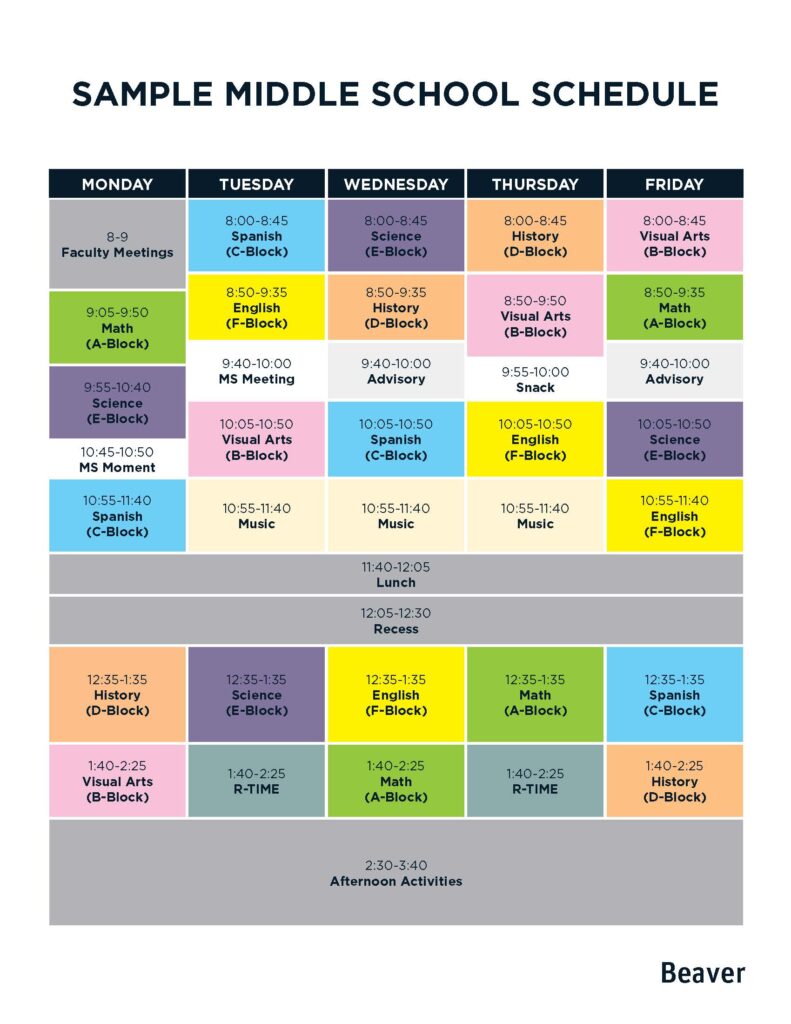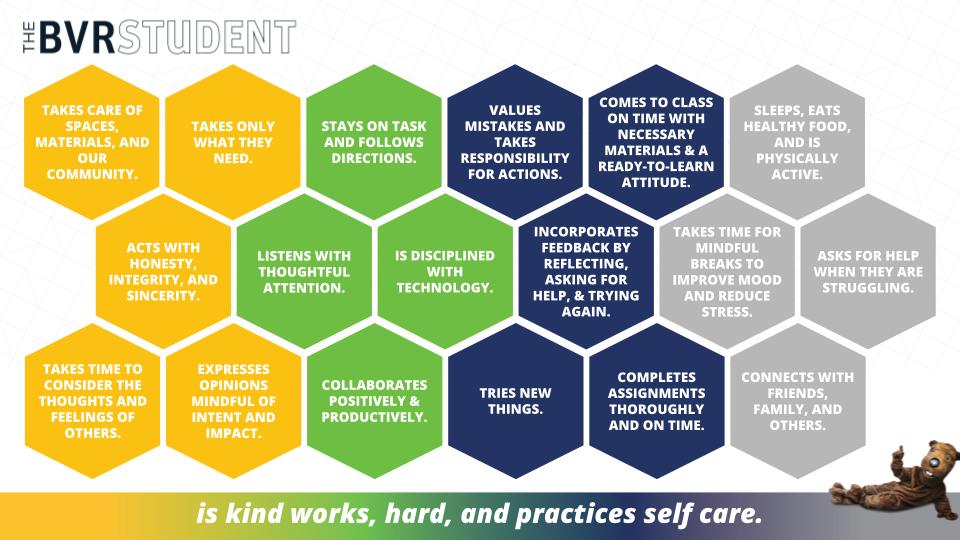In the Middle School, students pursue their interests and are pushed to try new things. They are challenged, which means that in addition to taking tests, writing papers, and preparing for class, our students also apply their learning to explore concepts further, growing as students and individuals.
The Middle School curriculum goes beyond simply memorizing facts; students explore different paths to a solution and share that process to explain their conclusion. They blog, debate, build, draw, code, act, and present their ideas through movies, workshops, podcasts, and so much more.
This work is dynamic, engaging, and innovative, and it happens during and outside of class—in groups, and individually.
Whether presenting in front of the entire Middle School, reading a book in another language, or devising their own play, we encourage our students to do things they may have never done before (or never thought they could do). We also teach them how to work with their peers to accomplish many different tasks, how to count on others, and how to be counted on.
Middle School is a time to try, make a mistake, learn from that mistake, and try again—in a supported and safe environment filled with dedicated adults who love working with MS students and who are committed to doing all they can to help students find success.
We intentionally ensure our students thrive in Middle School and are prepared for what’s next—at Beaver, in Upper School, and the world beyond.
Tiffany Smith, Director of Middle School
Middle School Course Catalog
By default, courses are organized alphabetically by title; to see requirements by grade-level, select the specific grade you’re looking for in the “Grade” dropdown.
Chinese A
This introductory course exposes students to Chinese through comprehensible input, including oral, written, and visual storytelling. The input-based approach to acquiring language focuses on the instruction of vocabulary in a highly contextualized manner. By keeping the conversation/story engaging and compelling, the learner is distracted from consciously trying to memorize vocabulary. Class time centers around developing fluency and students are encouraged to use their language skills wholistically. Emphasis is placed on fluency over precision, with a focus on students being comfortable communicating in simple sentences in Chinese.
Chinese B
A continuation of Chinese A, in Chinese B students continue to develop their fluency in the language. This course exposes students to Chinese through comprehensible input, including oral, written, and visual storytelling. The input-based approach to acquiring language focuses on the instruction of vocabulary in a highly contextualized manner. By keeping the conversation/story engaging and compelling, the learner is distracted from consciously trying to memorize vocabulary. Class time centers around developing fluency and students are encouraged to use their language skills wholistically. Emphasis is placed on fluency over precision, with a focus on students being comfortable communicating in more detail in Chinese.
Chinese C
A continuation of Chinese B, in Chinese C students continue to develop their fluency in the language. This course exposes students to Chinese through comprehensible input, including oral, written, and visual storytelling. The input-based approach to acquiring language focuses on the instruction of vocabulary in a highly contextualized manner. By keeping the conversation/story engaging and compelling, the learner is distracted from consciously trying to memorize vocabulary. Class time centers around developing fluency, and students are encouraged to use their language skills holistically. Emphasis is placed on fluency over precision, with a focus on students being comfortable communicating in more detail and elaborating on their ideas entirely in Chinese.
English 7
Why are there stories? What makes a story? How are stories told? What is our story? These essential questions guide our reading, writing, and discussion in 7th grade English. Considering the essential elements of a story leads to an exploration of the many different ways stories are told: from spoken word through literature, poetry, drama, art and song, into more modern modes like podcasts, movies, and animation. We investigate the struggle to ensure rights for all citizens by largely focusing on fictional accounts highlighting the time period between 1920 and the present. We study the tactics of great readers, learning to be aware of our thought processes while we read, developing strategies to better understand a given text. We focus on the iterative writing process and supporting our ideas with adequate details while extending the depth and quality of our work. Creative problem solving, empathy, effort, and collaboration are our cornerstones and are always honored.
English 8
The 8th grade English course focuses on identity, with narratives involving adolescent characters reflecting on their interactions and experiences, responding to injustice, and questioning the status quo. Students respond to readings in a variety of modes: collaborative projects, personal reflections, expository essays, and creative compositions. The creative assignments allow individual freedom, stimulate imagination, and inspire risk-taking. Expository pieces prompt students to reflect on and respond to their readings and typically adhere to the five-paragraph format with the iterative process involving brainstorming, outlining, drafting, and revising. Students are encouraged to explore original modes of expression such as song, video, and visual arts. In general, emphasis is placed on development of creative problem-solving, collaboration, and study skills.
French A
This introductory course exposes students to French through comprehensible input, including oral, written, and visual storytelling. The input-based approach to acquiring language focuses on the instruction of vocabulary in a highly contextualized manner. By keeping the conversation/story engaging and compelling, the learner is distracted from consciously trying to memorize vocabulary. Class time centers around developing fluency and students are encouraged to use their language skills wholistically. Emphasis is placed on fluency over precision, with a focus on students being comfortable communicating in simple sentences in French.
French B
A continuation of French A, in French B students continue to develop their fluency in the language. This course exposes students to French through comprehensible input, including oral, written, and visual storytelling. The input-based approach to acquiring language focuses on the instruction of vocabulary in a highly contextualized manner. By keeping the conversation/story engaging and compelling, the learner is distracted from consciously trying to memorize vocabulary. Class time centers around developing fluency and students are encouraged to use their language skills wholistically. Emphasis is placed on fluency over precision, with a focus on students being comfortable communicating in more detail in French.
French C
A continuation of French B, in French C students continue to develop their fluency in the language. This course exposes students to French through comprehensible input, including oral, written, and visual storytelling. The input-based approach to acquiring language focuses on the instruction of vocabulary in a highly contextualized manner. By keeping the conversation/story engaging and compelling, the learner is distracted from consciously trying to memorize vocabulary. Class time centers around developing fluency and students are encouraged to use their language skills wholistically. Emphasis is placed on fluency over precision, with a focus on students being comfortable communicating in more detail and elaborating on their ideas entirely in French.
History 7 – The History of the United States from Multiple Perspectives
In this course, students will examine essential questions that explore the themes of power, colonization, racism, revolution, resistance, and social change throughout the early history of the United States. The perspectives and experiences of oppressed groups including enslaved people, women, the poor, and Indigenous peoples will be brought to the forefront in our studies. Students will practice critical thinking skills and consider past and present day events through a social justice lens. Students will engage with inquiry-based projects and project based learning opportunities throughout the year.
History 8 – Ideologies in World History
Through a global lens, we will explore some of the major ideologies that have shaped the world, including global citizenship & cooperation, religion, colonialism, racism, and ways of governing. We will consider how we experience the world, locally and globally. We will investigate how ideologies have influenced nations, ideas, conflict, peace, & change. We will reflect on our relationship to these ideologies and refine our ideas & opinions as engaged citizens.
Your saved courses
Middle School Academics Information
Middle School Academic Contacts
-
Tiffany Smith
Director of Middle School - 617-738-2738
- Email Tiffany Smith
- Read Bio
-
Ann Bevan Hollos
Associate Director of Middle School - 617-738-2780
- Email Ann Bevan Hollos
- Read Bio
-
Terri Flannery
Associate Director of Academic Services - 617-738-2784
- Email Terri Flannery
- Read Bio

